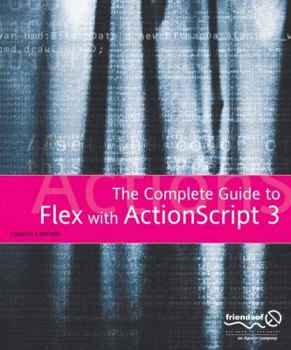The Essential Guide to Flex 2 with ActionScript 3.0: Friends of Ed Adobe Learning Library
ActionScript 3, Flex, and Flexbuilder 2 are the hot new technologies from Adobe that allow Flash developers to build more powerful Flash applications than ever before. This book is a comprehensive tutorial and reference guide that teaches readers everything they need to know about these new technologies, from the very beginning, right through advanced topics. Readers will need some general web development experience, and ideally have Flash and ActionScripting experience, although this isn't essential. This book is one of the first to offer thorough coverage of these new technologies. The author, Charles E. Brown, is an acknowledged expert in Flash development and training. His in-depth knowledge of application development and effective teaching methods is evident on every page of this essential handbook.
Customer Reviews
Rated 5 starsBest Flex ever...
concise and to the point. great read even if you've done other languages like ASP or Coldfusion. Definitely a keeper.
0Report
Rated 5 starsThis book rocks!
I purchased this book to learn about Flex 2 and ActionScript 3.0. I am an experienced programmer, though only a part-time one at work, but am new to both Flex and ActionScript. I really like Mr. Brown's approach throughout the book. Concepts are presented well and usually thoroughly. But, he always takes a step to the side to explain things a little further or tie the concept to other parts of the programming world. The...
0Report
Rated 5 starsGet Up to Speed With Flex 2 Fast
This is an excellent book that doesn't waste time and gets you up to speed in Flex 2 quickly. The author explains clearly how, what, and why you are doing each of the individual steps as you progress through the hands on tutorials. True, it is an easy read but you learn a lot by the time you are done. It is a great starting point and makes Flex 2 really fun. From here I'll go on to harder stuff. Initially, I did find...
0Report
Rated 5 starsFlex demystified!
Flex 2 with ActionScript 3.0 By Charles E. Brown Publisher: Friends of Ed Copyright 2007 IBSN:-13 (pbk) 978-1-59059-733-0 Reviewer: Linda Weller The author explains Flex in a very interesting instructive way. It explains the meaning of Flex and ActionScript 3.0 in the new Flash landscape. One of the great things about this book is that the author looks at all aspects of Flex from high/low levels and from a designer/developer...
0Report
Rated 5 starsExcellent
I've worked on several enterprise level applications (10,000+ users) and this book has helped me work through some of the initial problems I was having. If you're looking for a good book on how to integrate Flex 2 and Actionscript 3.0, you'll like this book.
0Report




















